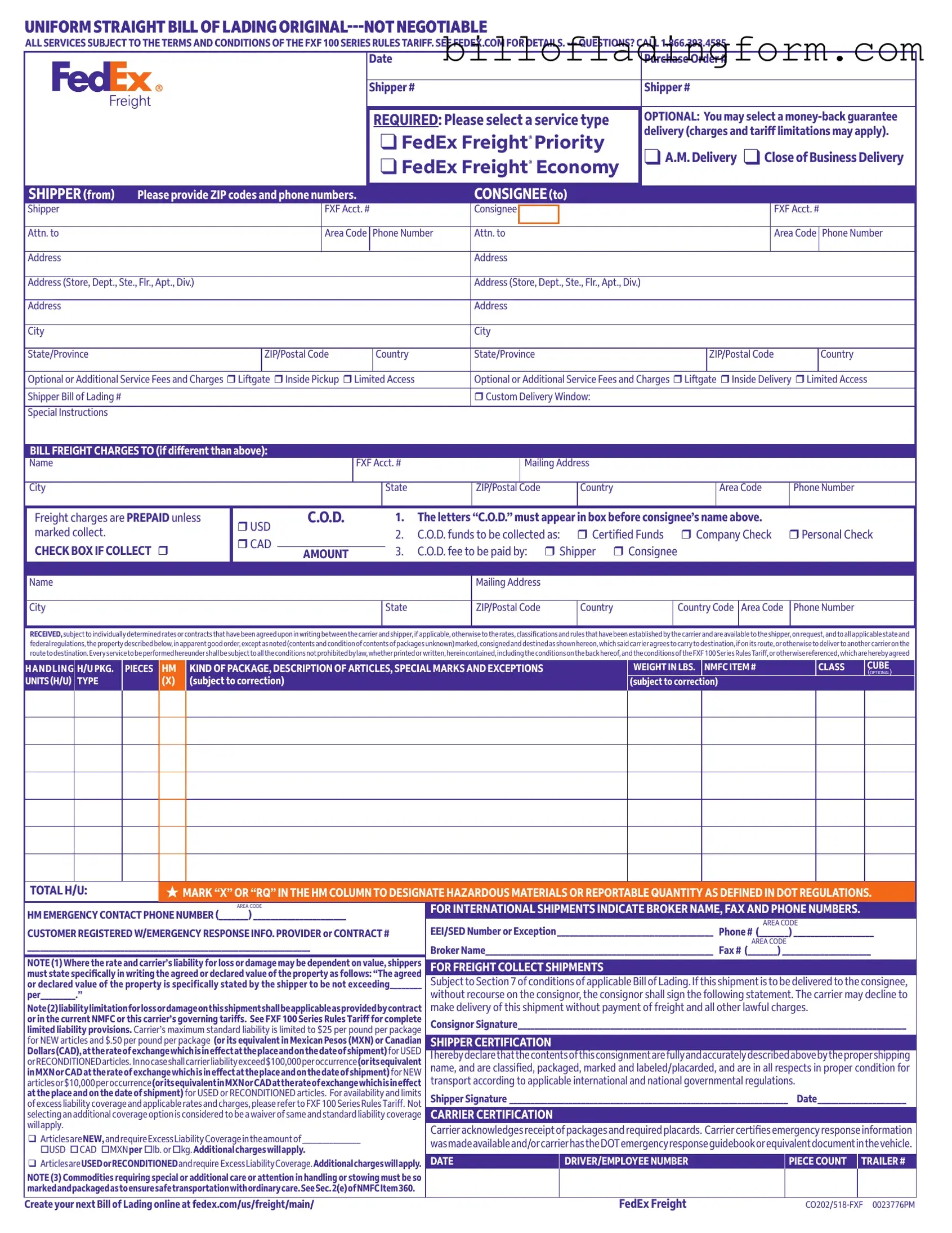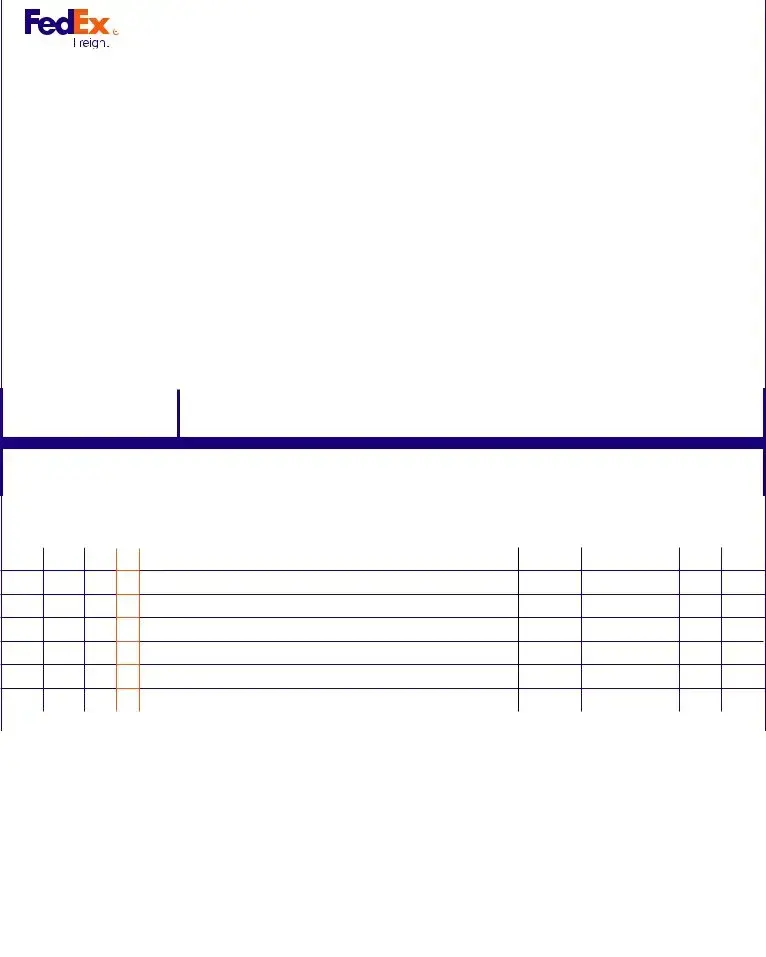ALL SERVICES SUBJECT TO THE TERMS AND CONDITIONS OF THE FXF 100 SERIES RULES TARIFF. SEE FEDEX.COM FOR DETAILS. --- QUESTIONS? CALL 1.866.393.4585
|
|
|
|
|
|
|
|
|
|
|
|
|
|
|
|
|
|
|
|
|
|
|
|
|
|
|
|
|
|
|
|
|
Date |
|
|
|
|
|
|
|
|
Purchase Order # |
|
|
|
|
|
|
|
|
|
|
|
|
|
|
|
|
|
|
|
|
|
|
|
|
|
|
|
|
|
|
|
|
|
Shipper # |
|
|
|
|
|
|
|
Shipper # |
|
|
|
|
|
|
|
|
|
|
|
|
|
|
|
|
|
|
|
|
|
|
|
|
|
|
|
|
REQUIRED: Please select a service type |
OPTIONAL: You may select a money-back guarantee |
|
|
|
|
|
|
|
|
q |
FedEx Freight |
® |
Priority |
delivery (charges and tariff limitations may apply). |
|
|
|
|
|
|
|
|
q A.M. Delivery q Close of Business Delivery |
|
|
|
|
|
|
|
|
|
|
|
|
|
|
|
|
|
|
|
|
|
|
|
q FedEx Freight® Economy |
|
|
|
|
|
|
|
|
|
|
|
|
|
|
|
SHIPPER (from) |
Please provide ZIP codes and phone numbers. |
|
|
|
|
|
|
CONSIGNEE (to) |
|
|
|
|
|
|
|
|
Shipper |
|
|
|
|
FXF Acct. # |
|
|
Consignee |
|
|
|
|
|
|
|
|
|
FXF Acct. # |
|
|
|
|
|
|
|
|
|
|
|
|
|
|
|
|
|
|
|
|
|
|
|
|
|
|
|
|
|
|
|
|
|
|
|
|
|
|
|
|
Attn. to |
|
|
|
|
Area Code |
|
Phone Number |
Attn. to |
|
|
|
|
|
|
|
|
Area Code |
Phone Number |
|
|
|
|
|
|
|
|
|
|
|
|
|
|
|
|
|
|
|
|
|
|
|
|
|
|
Address |
|
|
|
|
|
|
|
|
|
|
|
|
Address |
|
|
|
|
|
|
|
|
|
|
|
|
|
|
|
|
|
|
|
|
|
|
|
|
|
|
|
|
|
|
|
|
|
Address (Store, Dept., Ste., Flr., Apt., Div.) |
|
|
|
|
|
|
|
|
|
|
|
Address (Store, Dept., Ste., Flr., Apt., Div.) |
|
|
|
|
|
|
|
|
|
|
|
|
|
|
|
|
|
|
|
|
|
|
|
|
|
|
|
|
|
|
|
|
|
Address |
|
|
|
|
|
|
|
|
|
|
|
|
Address |
|
|
|
|
|
|
|
|
|
|
|
|
|
|
|
|
|
|
|
|
|
|
|
|
|
|
|
|
|
|
|
|
|
|
|
|
|
City |
|
|
|
|
|
|
|
|
|
|
|
|
City |
|
|
|
|
|
|
|
|
|
|
|
|
|
|
|
|
|
|
|
|
|
|
|
|
|
|
|
|
|
|
State/Province |
|
|
ZIP/Postal Code |
|
Country |
|
State/Province |
|
|
ZIP/Postal Code |
|
|
Country |
|
|
|
|
|
|
|
|
|
|
|
|
|
|
Optional or Additional Service Fees and Charges rLiftgate rInside Pickup rLimited Access |
|
Optional or Additional Service Fees and Charges rLiftgate rInside Delivery rLimited Access |
Shipper Bill of Lading # |
|
|
|
|
|
|
|
|
|
|
|
|
rCustom Delivery Window: |
|
|
|
|
|
|
|
Special Instructions |
|
|
|
|
|
|
|
|
|
|
|
|
|
|
|
|
|
|
|
|
|
|
|
|
|
|
|
|
|
|
|
|
|
|
|
|
|
|
|
|
|
|
|
|
|
|
|
|
|
BILL FREIGHT CHARGES TO (if different than above): |
|
|
|
|
|
|
|
|
|
|
|
|
|
|
|
|
|
|
|
|
|
|
Name |
|
|
|
|
|
FXF Acct. # |
|
|
|
Mailing Address |
|
|
|
|
|
|
|
|
|
|
|
|
|
|
|
|
|
|
|
|
|
|
|
|
|
|
|
|
|
|
City |
|
|
|
|
|
|
|
|
|
State |
|
ZIP/Postal Code |
Country |
|
|
Area Code |
|
Phone Number |
|
|
|
|
|
|
|
|
|
|
|
|
|
|
|
|
|
Freight charges are PREPAID unless |
USD |
C.O.D. |
|
|
1. |
The letters |
“C.O.D.” must appear |
in box before consignee’s name above. |
|
|
|
marked collect. |
|
|
|
|
2. |
C.O.D. funds to be collected as: |
Certified Funds Company Check |
Personal Check |
|
CAD |
|
|
|
CHECK BOX IF COLLECT |
|
|
|
|
|
|
|
|
|
|
|
|
|
|
|
|
|
|
|
|
|
|
AMOUNT |
3. |
C.O.D. fee to be paid by: Shipper Consignee |
|
|
|
|
|
|
|
|
REMIT C.O.D. TO (if different than shipper above):
|
|
TOTAL H/U: |
|
H MARK “X” OR “RQ” IN THE HM COLUMN TO DESIGNATE HAZARDOUS MATERIALS OR REPORTABLE QUANTITY AS DEFINED IN DOT REGULATIONS. |
|
|
|
|
|
|
FOR INTERNATIONAL SHIPMENTS INDICATE BROKER NAME, FAX AND PHONE NUMBERS. |
|
|
|
|
|
area code |
|
|
|
|
|
|
|
|
HM EMERGENCY CONTACT PHONE NUMBER (_______) ______________________ |
|
|
|
|
|
|
|
EEI/SED Number or Exception______________________________________ |
AREA CODE |
|
|
CUSTOMER REGISTERED W/EMERGENCY RESPONSE INFO. PROVIDER or CONTRACT # |
Phone # (_______) ___________________ |
|
___________________________________________________________________ |
Broker Name______________________________________________________ |
AREA CODE |
|
Fax # (_______) _____________________ |
|
|
NOTE (1) Where the rate and carrier’s liability for loss or damage may be dependent on value, shippers |
|
|
|
|
|
|
|
FOR FREIGHT COLLECT SHIPMENTS |
|
|
|
|
|
|
must state specifically in writing the agreed or declared value of the property as follows: “The agreed |
|
|
|
|
|
Subject to Section 7 of conditions of applicable Bill of Lading. If this shipment is to be delivered to the consignee, |
|
|
or declared value of the property is specifically stated by the shipper to be not exceeding________ |
|
|
per_________.” |
|
|
without recourse on the consignor, the consignor shall sign the following statement. The carrier may decline to |
|
|
Note(2)liabilitylimitationforlossordamageonthisshipmentshallbeapplicableasprovidedbycontract |
make delivery of this shipment without payment of freight and all other lawful charges. |
|
|
or in the current NMFC or this carrier’s governing tariffs. See FXF 100 Series Rules Tariff for complete |
Consignor Signature____________________________________________________________________________________________ |
|
|
limited liability provisions. Carrier’s maximum standard liability is limited to $25 per pound per package |
|
|
for NEW articles and $.50 per pound per package (or its equivalent in Mexican Pesos (MXN) or Canadian |
SHIPPER CERTIFICATION |
|
|
|
|
|
|
|
Dollars(CAD),attherateofexchangewhichisineffectattheplaceandonthedateofshipment)for USED |
Iherebydeclarethatthecontentsofthisconsignmentarefullyandaccuratelydescribedabovebythepropershipping |
|
|
orRECONDITIONEDarticles. Innocaseshallcarrierliabilityexceed$100,000peroccurrence(oritsequivalent |
name, and are classified, packaged, marked and labeled/placarded, and are in all respects in proper condition for |
|
|
inMXNorCADattherateofexchangewhichisineffectattheplaceandonthedateofshipment) for NEW |
|
|
articlesor$10,000peroccurrence(oritsequivalentinMXNorCADattherateofexchangewhichisineffect |
transport according to applicable international and national governmental regulations. |
|
|
at the place and on the date of shipment) for USED or RECONDITIONED articles. For availability and limits |
Shipper Signature___________________________________________________________________ Date_____________________ |
|
|
of excess liability coverage and applicable rates and charges, please refer to FXF 100 Series Rules Tariff. Not |
|
|
selecting an additional coverage option is considered to be a waiver of same and standard liability coverage |
CARRIER CERTIFICATION |
|
|
|
|
|
|
|
willapply. |
|
|
Carrier acknowledges receipt of packages and required placards. Carrier certifies emergency response information |
|
|
ArticlesareNEW,andrequireExcessLiabilityCoverageintheamountof_______________ |
wasmadeavailableand/orcarrierhastheDOTemergencyresponseguidebookorequivalentdocumentinthevehicle. |
|
|
oUSD oCAD oMXNper olb. orokg.Additionalchargeswillapply. |
|
|
ArticlesareUSEDorRECONDITIONEDandrequire ExcessLiabilityCoverage.Additionalchargeswillapply. |
DATE |
DRIVER/EMPLOYEE NUMBER |
|
PIECE COUNT |
TRAILER # |
|
|
NOTE (3) Commodities requiring special or additional care or attention in handling or stowing must be so |
|
|
|
|
|
|
|
|
markedandpackagedastoensuresafetransportationwithordinarycare.SeeSec.2(e)ofNMFCItem360. |
|
|
|
|
|
|
|
Create your next Bill of Lading online at fedex.com/us/freight/main/ |
|
FedEx Freight |
|
CO202/518-FXF 0023776PM |

